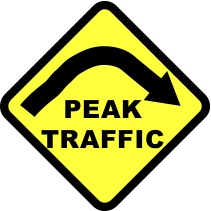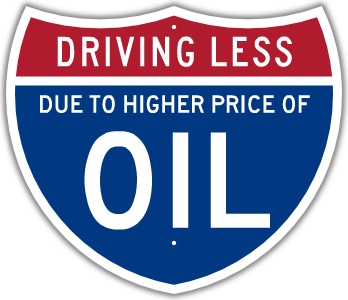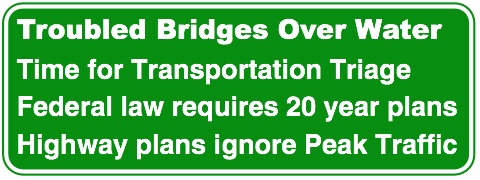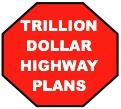55 miles per hour (90 kilometers per hour)
slow down to save oil, lower carbon emissions, reduce crash severity
related page:
The US could immediately reduce oil consumption by an estimated 4% by rolling back highway speed limits to 55 miles per hour - 90 kilometers per hour. This policy was originally enacted by Richard Nixon in the wake of the 1973 Saudi Oil Embargo. Lowering speed limits would reduce more oil consumption than the current flow through the Alaska Pipeline and would not require any technological innovations, merely psychological acceptance of the need for conservation. (statistic source: "Saving Oil in a Hurry: Oil Demand Restraint in Transport," by International Energy Agency, Workshop: Managing Oil Demand in Transport, Paris, 7-8 March, 2005)
US oil consumption - about 20 million barrels per day
over 7 billion barrels per year
4% of 7 billion = 280 millionAlaska pipeline flow in 2006: 277 million barrels (annual)
The fact that this simple solution, which only requires new signs, not new technologies, is not considered politically realistic shows that addressing the energy and climate crises is not a priority.

graphic from "Saving Oil in a Hurry"
Click here to hear the whole story:
nwpr.org/07/HomepageArticles/Article.aspx?n=3521
55 mph Speed Limit Resurfaces
Posted: Monday, January 28, 2008
OLYMPIA, WA - Freeway drivers take note. An old idea for saving gas is resurfacing as a response to global warming. Environmentalists in Washington State and California are lobbying to bring back the 55 mile-per-hour highway speed limit. Correspondent Tom Banse reports.
History buffs will recall we once had a nationwide 55 mile per hour speed limit. President Richard Nixon pushed for it in response to a 1973 oil crisis. It lasted until 1995.
Rasmussen: "We did it for 21 years for an emergency. I think we’ll do it again.”
Leavenworth, Washington environmentalist Pat Rasmussen says reducing the speed limit from 70 to 55 would cut tailpipe emissions by about 15 percent. She now drives 55 voluntarily.
Rasmussen: "I stay in the far right lane and I save a lot of gas and it doesn’t take that much more time."
The Washington governor’s climate change advisors recently considered lowering the speed limit. But the state traffic engineer worried about creating a new safety problem because some drivers won’t slow down. And the idea was dropped.
Pat Rasmussen
World Temperate Rainforest Network
PO Box 154
Peshastin, WA 98847
www.temperaterainforests.org
note: Spain also has an excellent intercity train network, including high speed rail between Madrid and Barcelona that goes about 300 kph (180 mph).
Spain cuts speed limit and turns out lights
By John Lichfield
Thursday, 31 July 2008
Spain has seen the future and it is slow, dim and uncomfortable. A swingeing series of energy-saving measures announced by the Spanish government may be a foretaste of the kind of policies which will be forced upon an energy-hungry industrial world in the coming decades.
To protests from motorists and mockery in parts of the press, the Socialist government plans to cut motorway speed limits to 50mph and town speeds to 25mph. New austerity rules will be imposed on the air conditioning and heating of all public buildings. Street-lighting will be cut by half.
Almost 50 million low-energy light bulbs will be handed out by the government in an attempt to drive high-consumption bulbs out of the market in the next four years. The government will also sponsor a project intended to introduce a million electric or hybrid electric-petrol cars on to Spanish roads by 2014.
http://news.yahoo.com/s/ap/20080703/ap_on_go_co/warner_speed_limit
Senator asks if nation's drivers should slow down
By H. JOSEF HEBERT, Associated Press Writer
Thu Jul 3, 2008
WASHINGTON - An influential Republican senator suggested Thursday that Congress might want to consider reimposing a national speed limit to save gasoline and, in turn possibly ease fuel prices.
Sen. John Warner, R-Va., asked Energy Secretary Samuel Bodman to look into what speed limit would provide optimum gasoline efficiency given current technology. He said he wants to know if the administration might support efforts in Congress to require a lower speed limit.
Congress in 1974 set a national 55 mph speed limit because of energy shortages caused by the Arab oil embargo. The speed limit was repealed in 1995 when crude oil dipped to $17 a barrel and gasoline cost $1.10 a gallon.
As motorists headed on trips for this Fourth of July weekend, gasoline averaged $4.10 a gallon nationwide with oil hovering around $145 a barrel.
Warner cited studies that showed the 55 mph speed limit saved 167,000 barrels of oil a day, or 2 percent of the country's highway fuel consumption, while avoiding up to 4,000 traffic deaths a year.
"Given the significant increase in the number of vehicles on America's highway system from 1974 to 2008, one could assume that the amount of fuel that could be conserved today is far greater," Warner wrote Bodman.
Warner asked the department to determine at what speeds vehicles would be most fuel efficient, how much fuel savings would be achieved, and whether it would be reasonable to assume there would be a reduction in prices at the pump if the speed limit were lowered.
Energy Department spokeswoman Angela Hill said the department will review Warner's letter but added, "If Congress is serious about addressing gasoline prices, they must take action on expanding domestic oil and natural gas production."
The department's Web site says that fuel efficiency decreases rapidly when traveling faster than 60 mph. Every additional 5 mph over that threshold is estimated cost motorists an additional 30 cents per gallon in fuel costs, Warner said in his letter, citing the DOE data.
http://news.yahoo.com/s/csm/20080715/cm_csm/ydillin
Patriotic answer to $4-a-gallon gas: Drive less, and slow down
By John Dillin
Christian Science Monitor
Tue Jul 15, 4:00 AM ET
Washington - Three decades ago, during an earlier energy crisis, Ronald Reagan strode into an Atlanta hotel for a political meeting. As he approached the auditorium, someone asked:
"Governor Reagan, as a conservative, don't you think the 55 miles-per-hour speed limit imposed by the government to save gas is a violation of our freedom?"
In his amiable manner, Reagan chuckled quietly and, as I recall, he replied something like this:
"Well, that could be. But, speaking just personally, I think it's not a bad thing if we all slow down just a bit and enjoy the scenery a little more."
We could all use that kind of common sense today as gas rises past $4.
Many ideas are being put forth to ameliorate an energy-price crisis that threatens job security and economic growth in the United States.
Famous oilman T. Boone Pickens wants to build huge turbines all over the Midwest to harness wind energy.
Many members of Congress want to drill in the Arctic National Wildlife Refuge (ANWR) where – at today's prices – there is probably $1 trillion worth of oil waiting to be pumped.
In California, moves are afoot to make the state the renewable energy capital of the nation.
But – and there always seems to be a "but" – all of those ideas take time. Five years to build substantial wind farms. Ten years to tap Arctic oil.
Meanwhile, The Wall Street Journal has published predictions that a barrel of oil could reach $200 as soon as the end of this year. If that happens, gasoline would hit $6 a gallon.
Woe is us.
Or maybe not.
Instead, the time may be ripe for individual citizen action – like the Minutemen of 1775. After all, isn't that how we got this great country started 233 years ago?
There are two steps we can take right away that could have greater impact than oil from the Arctic. They are so simple and straightforward that they are seldom mentioned. But Americans took these steps during World War II, and they worked.
First, drive slower.
Second, drive less.
The savings of gasoline from these two steps would be phenomenal. (More on that in a moment.)
During World War II, Congress and President Franklin Roosevelt mandated a nationwide 35 m.p.h. speed limit. At that time, 35 m.p.h. was the most efficient speed for autos. Even more important, it helped preserve automobile tires, which was crucial because Japan had cut off American access to natural rubber from Southeast Asia.
Today, 35 m.p.h. is no longer the best speed for autos with their sleek designs and advanced transmissions. Newer vehicles generally get the highest gas mileage somewhere between 45 and 55 m.p.h., says David L. Greene of the National Transportation Research Center at Oak Ridge National Laboratory in Knoxville, Tenn.
The main force reducing mileage is air drag, says Dr. Greene. The faster you go, the greater the drag. Drag forces increase exponentially, so doubling your speed from 40 to 80 increases drag fourfold.
It makes a huge difference, for at 80 m.p.h. your car pushes against wind with the force of a hurricane.
Consumer Reports tested the effect of higher speeds on gas mileage. David Champion, director of auto testing, found that boosting the highway speed of a 2006 Toyota Camry cut gasoline mileage dramatically:
•55 m.p.h. – 40.3 miles per gallon
•65 m.p.h. – 34.9 miles per gallon
•75 m.p.h. – 29.8 miles per gallon
On a hypothetical 1,900-mile round trip from New York City to Disney World in Florida, the Camry would use 47 gallons of gas at 55 m.p.h.. But at 75 m.p.h., it would burn nearly 64 gallons – a $70 difference.
Ideally, if we all bought 45 m.p.g. Toyota Prius hybrids, US gasoline use would drop in half, from 9.3 million barrels per day, to under 5 million barrels a day. Of course, that won't happen.
So a practical and immediate response would be not only to drive slower, but also drive less. Government made that happen in World War II by limiting most drivers to four gallons of gas per week.
That's unlikely now. But consider this: If everyone could reduce their driving by just 10 percent, the savings would total nearly 1 million barrels of gasoline every day.
How much is that? Well, it amounts to about half our daily oil imports from Saudi Arabia. It also would be equal to the highest expected production of oil if we drill in ANWR. And we can do it today.
Mr. Pickens notes that America will spend $10 trillion in the next 10 years on imported oil. US wealth is draining fast overseas.
But as individuals, we can turn this around. Today. Don't wait for Barack Obama, or John McCain, or some whiz kid in Silicon Valley to solve this problem. None of them can do it quick enough.
It's up to us. Save gas, and win this fight.
• John Dillin is a former managing editor of the Monitor.
http://news.yahoo.com/s/ap/20080322/ap_on_re_us/slower_truckers
Truckers slowing down to save fuel
By JAMES MacPHERSON, Associated Press WriterSat Mar 22, 12:50 PM ET
BISMARCK, N.D. - Coast-to-coast trucker Lorraine Dawson says fellow drivers used to call her "Lead Foot Lorraine." But with diesel fuel around $4 a gallon, she and other big-rig drivers have backed off their accelerators to conserve fuel.
"I used to be a speed demon, but no more," said Dawson, based atTacoma, Wash. "Most drivers have cut their speed considerably."
Dawson said she's cut her speed by five to 10 miles per hour to save money for her company. Many independent owner-operators have slowed even more, she said.
"My fiance is an owner-operator and he's been crying a lot about the price of fuel," Dawson said. "He's been slowing way down."
Truckers and industry officials say slowing a tractor-trailer rig from 75 mph to 65 mph increases fuel mileage by more than a mile a gallon, a significant bump for machines that get less than 10 miles per gallon hauling thousands of pounds of freight. Even sitting still with the engine idling, a rig gulps about a gallon of diesel every hour.
"We just can't afford it," Dawson said of diesel as she was topping off her fuel tanks at a Bismarck truck stop.
When she started driving trucks in 1997, diesel was about $1.97 a gallon, $2 a gallon cheaper than what she paid Wednesday in Bismarck. Rigs like hers have two fuel tanks, typically holding 300 gallons each.
The nationwide average for a gallon of diesel on Thursday was $4.03, up from $2.74 one year earlier, AAA North Dakota spokesman Gene LaDoucer said. The average inNorth Dakota on Thursday was $3.98, up from $2.82 a year ago, he said.
"Twenty-four states are paying $4 or higher," LaDoucer said Thursday.
The climb is blamed on record crude oil prices and global demand, LaDoucer said.
"Diesel is the predominate fuel used in foreign countries, and there is a lot more demand for it globally and that helps bid up the price that we are paying here," LaDoucer said.
Fuel accounts for about a quarter of carriers' operating costs, and now is surpassing labor as the biggest expense for some carriers, said Tiffany Wlazlowski, a spokeswoman for the Arlington, Va.-based American Trucking Associations.
"And rising fuel costs do increase the cost of consumer goods," she said.
Trucks haul 70 percent of all freight tonnage in the U.S., according to the American Trucking Associations.
State troopers have noticed the decline in truckers' speeds, said North Dakota Highway Patrol Capt. Eric Pederson.
"We see it when we're out patrolling," Pederson said. "In talking to the drivers, a lot of the large companies are setting policies that give the drivers a little more leeway on the time on their loads — just to save on the fuel."
Wlazlowski said the U.S trucking industry expects to spend $135 billion on diesel this year, up from $112 billion in 2007. There are 3.5 million truck drivers in this country, she said.
"For every one-penny increase in the price of diesel, it costs our industry $391 million," she said. "In the last month, it's gone up 50 cents."
Wlazlowski said the trucking industry does "anything that will help them save fuel." She said that includes outfitting trucks with aerodynamic fairings and special tires to improve mileage. Drivers also are using more efficient routes and reducing idling times.
Trucking company Con-way Inc. of Ann Arbor, Mich., announced this month that it adjusted speed governors on the engines of the 8,400 semis in its less-than-truckload division, Con-way Freight.
Truckload carriers usually dedicate a shipment to a single customer, and move freight directly from the shipper to the receiver. Less-than-truckload carriers are filled with shipments from multiple customers, and may redistribute it at terminals along routes.
Con-way spokesman Gary Frantz said the maximum speed of the trucks has been cut from 65 mph to 62, a move that should cut fuel consumption by 3.2 million gallons a year.
"It's a significant savings," Frantz said.
The company said the move also would eliminate 72 million pounds of carbon emissions annually, or the equivalent to removing nearly 7,300 automobiles from U.S. highways.
Frantz said the company should have the governors on the 3,000 rigs in its truckload fleet adjusted next month.
http://apnews.myway.com/article/20080501/D90D1J1O0.html
Airlines slow down flights to save on fuel
May 1, 3:23 PM (ET)
By JOHN WILEN
NEW YORK (AP) - Drivers have long known that slowing down on the highway means getting more miles to the gallon. Now airlines are trying it, too - adding a few minutes to flights to save millions on fuel.
Southwest Airlines started flying slower about two months ago, and projects it will save $42 million in fuel this year by extending each flight by one to three minutes.
On one Northwest Airlines flight from Paris to Minneapolis earlier this week alone, flying slower saved 162 gallons of fuel, saving the airline $535. It added eight minutes to the flight, extending it to eight hours, 58 minutes.
That meant flying at an average speed of 532 mph, down from the usual 542 mph.








